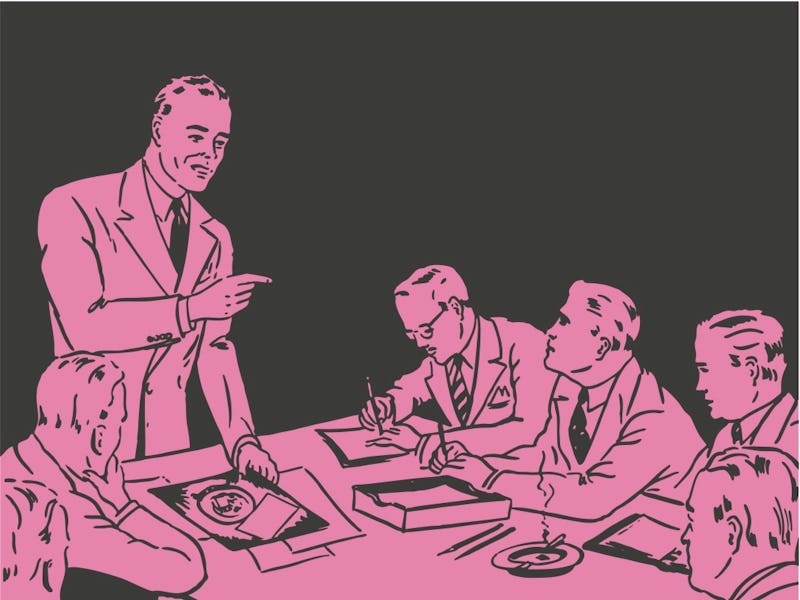What will the future office look like? Experts predict one big change
And it's posed for another reinvention within the coming months.

Be honest: During your most recent in-person meeting (likely months ago, but think back), were you actively engaged in the conversation or sneaking a peek at your phone?
The rooms meetings are held in have significantly evolved since their modern iterations were introduced in the 1950s. Back then, many of us wouldn’t have even been allowed into the room much less have a seat at the table. But as workplaces became more equitable and collaborative, these rooms have changed, and they’re posed for another reinvention within the coming months.
The problem
What we think of as the modern meeting room came to be in the middle of the 20th Century with the rise of modernism in architecture, according to Christian Giordano, president and owner of Mancini Duffy. During this time, companies started to place more focus on the aesthetics of the interiors of their buildings, and thus meeting rooms took shape. A prominent early adopter of these spaces was Bell Labs, which continues to have offices across the country.
These rooms were only reserved for executives, and they were typically placed on separate floors — the executive suites. “Most employees wouldn’t have even dreamed of using them,” Giordano said. Meeting rooms were only used a few times per year and catered food was served. (Many corporations and banking institutions maintain this setup.)
The solution
The end of the century brought with it a big change to office design: many employees were now working in cubicles.
“In the late ‘80s and ‘90s people worked in high cubicles,” Giordano said. “You wouldn’t even know the person next to you. The meeting room got people out of those spaces. These rooms were dispersed throughout the floor plan of an office and became the focus of an office. There were only a certain amount of steps until you came into another meeting room and they became less formal.”
While cubicles served a clear purpose, they were also easy cultural targets. Films of all genres in the '90s went after the cubicle without mercy, ranging from Office Space to Fight Club to The Matrix. These films all used the cubicle similarly, to suggest that they stripped away individuality. Teenagers watching these films swore up and down they would never work somewhere so soul-crushing, and the seeds for the next wave of offices began to germinate.
Throughout the 2000s, as offices became more digitized, there was a greater need for meeting rooms to be packed with technology for conference calls and presentations. Outfitting these rooms became expensive, reaching as much as $20,000 per room, according to Kristin Celano, head of brand marketing at Owl Labs, maker of a video conferencing camera.
The evolution
The popularization of the smartphone at the end of the ‘00s brought opposing developments to meetings and the rooms they’re held in. On one hand, mobile technology gave “designers the flexibility to make meeting rooms smaller, because employees today bring their own tech — phones, laptops, etc. — to meetings,” Giordano said. On the other hand, “The smartphone and laptop made the meeting useless, because no one actually pays attention to the meeting.” (Companies have debated banning smartphones in meetings since.)
This opened the door for startups including Owl Labs and HuddleCamHD to offer more affordable solutions for video conferencing, shedding the need for expensive hardlines that had been required in meeting rooms.
“Computers can now run software that is dedicated to collaboration and connected with online workspaces in a way that is dynamic and productive,” said Paul Richards, director of business development at HuddleCamHD. “With the move to cloud-based video communications being so prevalent, meetings can be joined from any smartphone, laptop, or internet-connected device.”
The availability of these tools went hand in hand with a further casualization of meetings, which gave teams the chance to “meet, brainstorm, and congregate,” Giordano said. “Tech companies and millennials took it to the next level. In the past five to eight years it became less about a meeting room than an area. Meetings are held out in the open.”
The future
All of these developments around meetings, in a way, prepared us for our current work-from-home situation. The ease and familiarity around the use of teleconferencing tools made the transition to remote teams a bit easier. However, as the return to offices take shape, meeting rooms will still be important, but their function is up for debate (until virtual and augmented reality workplace applications go mainstream).
Giordano said that offices may only serve the function of meeting and collaboration areas, with individual work done in home offices. This in turn may lead to larger offices in which people are more spread out.
This shift will likely be a boon for companies such as Owl Labs and HuddleCamHD. Richards said he envisions that many meeting rooms will become more like TV production studios rather than collaborative spaces.
“We still need creative rooms to collaborate and meet, but the ease of meeting from your desk is tough to match,” Richards said. “Meeting rooms can no longer be used for simple communications.”
Celano echoed these remarks. “Once the return-to-office shift begins, there will be more of a need than ever for products that seamlessly connect in-office and remote employees,” Celano said. “Every meeting room in an office space will have to be equipped to connect to the outside world, or else will be essentially useless.”